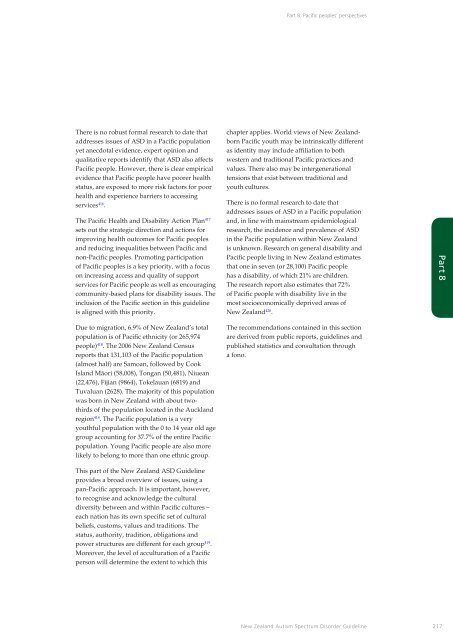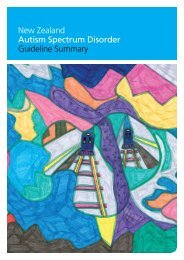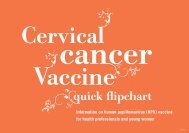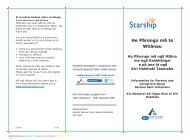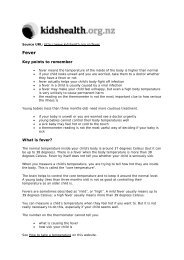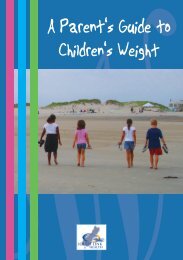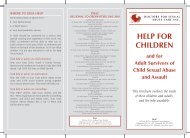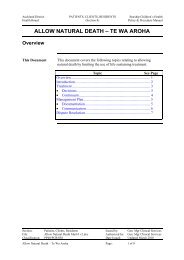New Zealand Autism Spectrum Disorder Guideline - Ministry of Health
New Zealand Autism Spectrum Disorder Guideline - Ministry of Health
New Zealand Autism Spectrum Disorder Guideline - Ministry of Health
You also want an ePaper? Increase the reach of your titles
YUMPU automatically turns print PDFs into web optimized ePapers that Google loves.
Part 8: Pacific peoples’ perspectives<br />
There is no robust formal research to date that<br />
addresses issues <strong>of</strong> ASD in a Pacific population<br />
yet anecdotal evidence, expert opinion and<br />
qualitative reports identify that ASD also affects<br />
Pacific people. However, there is clear empirical<br />
evidence that Pacific people have poorer health<br />
status, are exposed to more risk factors for poor<br />
health and experience barriers to accessing<br />
services 416 .<br />
The Pacific <strong>Health</strong> and Disability Action Plan 417<br />
sets out the strategic direction and actions for<br />
improving health outcomes for Pacific peoples<br />
and reducing inequalities between Pacific and<br />
non-Pacific peoples. Promoting participation<br />
<strong>of</strong> Pacific peoples is a key priority, with a focus<br />
on increasing access and quality <strong>of</strong> support<br />
services for Pacific people as well as encouraging<br />
community-based plans for disability issues. The<br />
inclusion <strong>of</strong> the Pacific section in this guideline<br />
is aligned with this priority.<br />
chapter applies. World views <strong>of</strong> <strong>New</strong> <strong>Zealand</strong>born<br />
Pacific youth may be intrinsically different<br />
as identity may include affiliation to both<br />
western and traditional Pacific practices and<br />
values. There also may be intergenerational<br />
tensions that exist between traditional and<br />
youth cultures.<br />
There is no formal research to date that<br />
addresses issues <strong>of</strong> ASD in a Pacific population<br />
and, in line with mainstream epidemiological<br />
research, the incidence and prevalence <strong>of</strong> ASD<br />
in the Pacific population within <strong>New</strong> <strong>Zealand</strong><br />
is unknown. Research on general disability and<br />
Pacific people living in <strong>New</strong> <strong>Zealand</strong> estimates<br />
that one in seven (or 28,100) Pacific people<br />
has a disability, <strong>of</strong> which 21% are children.<br />
The research report also estimates that 72%<br />
<strong>of</strong> Pacific people with disability live in the<br />
most socioeconomically deprived areas <strong>of</strong><br />
<strong>New</strong> <strong>Zealand</strong> 420 .<br />
Part 8<br />
Due to migration, 6.9% <strong>of</strong> <strong>New</strong> <strong>Zealand</strong>’s total<br />
population is <strong>of</strong> Pacific ethnicity (or 265,974<br />
people) 418 . The 2006 <strong>New</strong> <strong>Zealand</strong> Census<br />
reports that 131,103 <strong>of</strong> the Pacific population<br />
(almost half) are Samoan, followed by Cook<br />
Island Mäori (58,008), Tongan (50,481), Niuean<br />
(22,476), Fijian (9864), Tokelauan (6819) and<br />
Tuvaluan (2628). The majority <strong>of</strong> this population<br />
was born in <strong>New</strong> <strong>Zealand</strong> with about twothirds<br />
<strong>of</strong> the population located in the Auckland<br />
region 418 . The Pacific population is a very<br />
youthful population with the 0 to 14 year old age<br />
group accounting for 37.7% <strong>of</strong> the entire Pacific<br />
population. Young Pacific people are also more<br />
likely to belong to more than one ethnic group.<br />
This part <strong>of</strong> the <strong>New</strong> <strong>Zealand</strong> ASD <strong>Guideline</strong><br />
provides a broad overview <strong>of</strong> issues, using a<br />
pan-Pacific approach. It is important, however,<br />
to recognise and acknowledge the cultural<br />
diversity between and within Pacific cultures –<br />
each nation has its own specific set <strong>of</strong> cultural<br />
beliefs, customs, values and traditions. The<br />
status, authority, tradition, obligations and<br />
power structures are different for each group 419 .<br />
Moreover, the level <strong>of</strong> acculturation <strong>of</strong> a Pacific<br />
person will determine the extent to which this<br />
The recommendations contained in this section<br />
are derived from public reports, guidelines and<br />
published statistics and consultation through<br />
a fono.<br />
<strong>New</strong> <strong>Zealand</strong> <strong>Autism</strong> <strong>Spectrum</strong> <strong>Disorder</strong> <strong>Guideline</strong> 217


